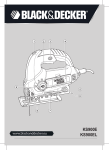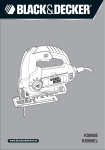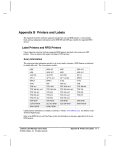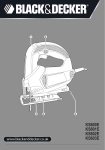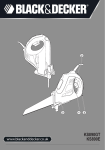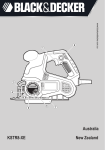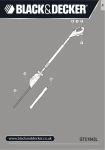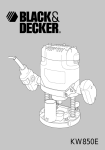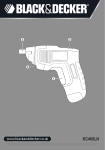Download Black & Decker KS900EL Instruction manual
Transcript
www.blackanddecker.co.uk KS900E KS900EL English 2 (Original instructions) 6 3 4 5 Intended use Your Black & Decker jigsaw has been designed for sawing wood, plastics and metal. This tool is intended for consumer use only. Safety instructions General power tool safety warnings Warning! Read all safety warnings and all ! instructions. Failure to follow all instructions may result in electric shock, fire and/or serious injury. Save all warnings and instructions for future reference. The term "power tool" in all of the warnings listed below refers to your mains operated (corded) power tool or battery operated (cordless) power tool. 1. Work area safety a. Keep work area clean and well lit. Cluttered and dark areas invite accidents. b. Do not operate power tools in explosive atmospheres, such as in the presence of flammable liquids, gases or dust. Power tools create sparks which may ignite the dust or fumes. c. Keep children and bystanders away while operating a power tool. Distractions can cause you to lose control. 2. Electrical safety a. Power tool plugs must match the outlet. Never modify the plug in any way. Do not use any adapter plugs with earthed (grounded) power tools. Unmodified plugs and matching outlets will reduce risk of electric shock. b. Avoid body contact with earthed or grounded surfaces such as pipes, radiators, ranges and refrigerators. There is an increased risk of electric shock if your body is earthed or grounded. c. Do not expose power tools to rain or wet conditions. Water entering a power tool will increase the risk of electric shock. d. Do not abuse the cord. Never use the cord for carrying, pulling or unplugging the power tool. Keep cord away from heat, oil, sharp edges or moving parts. Damaged or entangled cords increase the risk of electric shock. e. When operating a power tool outdoors, use an extension cord suitable for outdoor use. Use of a cord suitable for outdoor use reduces the risk of electric shock. 6 f. If operating a power tool in a damp location is unavoidable, use a Residual Current Device (RCD) protected supply. Use of an RCD reduces the risk of electric shock. 3. Personal safety a. Stay alert, watch what you are doing and use common sense when operating a power tool. Do not use a power tool while you are tired or under the influence of drugs, alcohol or medication. A moment of inattention while operating power tools may result in serious personal injury. b. Use personal protective equipment. Always wear eye protection. Protective equipment such as dust mask, non-skid safety shoes, hard hat, or hearing protection used for appropriate conditions will reduce personal injuries. c. Prevent unintentional starting. Ensure the switch is in the off-position before connecting to power source and/or battery pack, picking up or carrying the tool. Carrying power tools with your finger on the switch or energising power tools that have the switch on invites accidents. d. Remove any adjusting key or wrench before turning the power tool on. A wrench or a key left attached to a rotating part of the power tool may result in personal injury. e. Do not overreach. Keep proper footing and balance at all times. This enables better control of the power tool in unexpected situations. f. Dress properly. Do not wear loose clothing or jewellery. Keep your hair, clothing and gloves away from moving parts. Loose clothes, jewellery or long hair can be caught in moving parts. g. If devices are provided for the connection of dust extraction and collection facilities, ensure these are connected and properly used. Use of these devices can reduce dust related hazards. 4. Power tool use and care a. Do not force the power tool. Use the correct power tool for your application. The correct power tool will do the job better and safer at the rate for which it was designed. b. Do not use the power tool if the switch does not turn it on and off. Any power tool that cannot be controlled with the switch is dangerous and must be repaired. c. Disconnect the plug from the power source and/or the battery pack from the power tool before making any adjustments, changing accessories, or storing power tools. Such preventive safety measures reduce the risk of starting the power tool accidentally. d. Store idle power tools out of the reach of children and do not allow persons unfamiliar with the power tool or these instructions to operate the power tool. Power tools are dangerous in the hands of untrained users. e. Maintain power tools. Check for misalignment or binding of moving parts, breakage of parts and any other condition that may affect the power tools operation. If damaged, have the power tool repaired before use. Many accidents are caused by poorly maintained power tools. f. Keep cutting tools sharp and clean. Properly maintained cutting tools with sharp cutting edges are less likely to bind and are easier to control. g. Use the power tool, accessories and tool bits etc. in accordance with these instructions, taking into account the working conditions and the work to be performed. Use of the power tool for operations different from those intended could result in a hazardous situation. 5. Service h. Have your power tool serviced by a qualified repair person using only identical replacement parts. This will make sure that the safety of the power tool is maintained. Additional power tool safety warnings ! Warning! Additional safety warnings for jigsaws. Hold power tool by insulated gripping surfaces, when performing an operation where the cutting accessory may contact hidden wiring or its own cord. Cutting accessory contacting a "live" wire may make exposed metal parts of the power tool "live" and could give the operator an electric shock. Use clamps or another practical way to secure and support the workpiece to a stable platform. Holding the work by hand or against your body leaves it unstable and may lead to loss of control. Keep hands away from cutting area. Never reach underneath the work piece any reason. Do not insert fingers or thumb into the vicinity of the reciprocating blade and blade clamp. Do not stabilize the saw by gripping the shoe. Keep blades sharp. Dull or damaged blades may cause the saw to swerve or stall under pressure. Always use the appropriate type of saw blade for the workpiece material and type of cut. When cutting pipe or conduit, make sure that they are free from water, electrical wiring, etc. Do not touch the workpiece or the blade immediately after operating the tool. They can become very hot. Be aware of hidden hazards, before cutting into walls, floors or ceilings, check for the location of wiring and pipes. The blade will continue to move after releasing the switch. Always switch the tool off and wait for the saw blade to come to a complete standstill before putting the tool down. Warning! Contact with, or inhalation of dusts arising from cutting applications may endanger the health of the operator and possible bystanders. Wear a dust mask specifically designed for protection against dust and fumes and ensure that persons within or entering the work area are also protected. The intended use is described in this instruction manual. The use of any accessory or attachment or performance of any operation with this tool other than those recommended in this instruction manual may present a risk of personal injury and/or damage to property. Safety of others This appliance is not intended for use by persons (including children) with reduced physical, sensory or mental capabilities, or lack of experience and knowledge, unless they have been given supervision or instruction concerning the use of the appliance by a person responsible for the their safety. Children should be supervised to ensure that they do not play with the appliance. Vibration The declared vibration emission values stated in the technical data and the declaration of conformity have been measured in accordance with a standard test method provided by EN 60745 and may be used for comparing one tool with another. The declared vibration emission value may also be used in a preliminary assessment of exposure. Warning! The vibration emission value during actual use of the power tool can differ from the declared value depending on the ways in which the tool is used. The vibration level may increase above the level stated. 7 When assessing vibration exposure to determine safety measures required by 2002/44/EC to protect persons regularly using power tools in employment, an estimation of vibration exposure should consider, the actual conditions of use and the way the tool is used, including taking account of all parts of the operating cycle such as the times when the tool is switched off and when it is running idle in addition to the trigger time. Labels on tools Warning!To reduce the risk of injury, the user must read the instruction manual. Electrical safety This tool is double insulated; therefore no earth wire is required. Always check that the power supply corresponds to the voltage on the rating plate. If the supply cord is damaged, it must be replaced by the manufacturer or an authorised Black & Decker Service Centre in order to avoid a hazard. Additional safety instructions for non-rechargeable batteries Never attempt to open for any reason. Do not store in locations where the temperature may exceed 40°C. When disposing of batteries, follow the instructions given in the section "Protecting the environment". Do not incinerate the batteries. Under extreme conditions, battery leakage may occur. When you notice liquid on the batteries, proceed as follows: - Carefully wipe the liquid off using a cloth. Avoid skin contact. Additional safety instructions for lasers Read all of this manual carefully. This product is not to be used by children under 16. Laser radiation. Do not look into the laser beam. 8 Do not use optical tools to view the laser beam. This laser complies with class 2 according to EN 608251:2007. Do not replace a laser diode with a different type. If the laser is damaged, have the laser repaired by an authorised repair agent. Do not use the laser for any purpose other than projecting laser lines. An exposure of the eye to the beam of a class 2 laser is considered safe for a maximum of 0.25 seconds. Eyelid reflexes will normally provide adequate protection. At distances greater than 1m, the laser complies with class 1 and is therefore considered completely safe. Never look into the laser beam directly and intentionally. Do not use optical tools to view the laser beam. Do not set up the tool where the laser beam can cross any person at head height. Do not let children come near the laser. Features 1. Variable speed control knob 2. On/off switch 3. Lock-on button 4. Blade storage compartment cover 5. Shoe plate locking lever 6. Dust extraction outlet 7. Shoe plate 8. Saw blade support roller 9. Pendulum stroke selector Additional features (fig. A) Additional features may be applicable depending upon the product purchased. The additional features applicable to the catalogue number purchased are shown in fig. A. Assembly Warning!Before attempting any of the following operations, make sure that the tool is switched off and unplugged and that the saw blade has stopped. Used saw blades may be hot. Fitting and removing the saw blade (fig. B and C) Warning!Before attempting any of the following operations, make sure that the tool is switched off and unplugged and that the saw blade has stopped. Used saw blades may be hot. Fitting the saw blade (fig. B) Hold the saw blade (10) as shown, with the teeth facing forward. Push and hold the blade clamp (11) down. Insert the shank of the saw blade into the blade holder (12) as far as it will go. Release the blade clamp (11). Saw blade storage (fig. C) Saw blades (10) can be stored in the storage compartment (4) located on the side of the tool. Open the cover of the saw blade storage compartment (4) by holding the tab on the top of the cover and pulling it outward. The blades are retained in the compartment by a magnetic strip. To remove a blade, press down on one end of the blade to raise the other end, and remove. Close the cover of the saw blade storage compartment (4) and make sure that it is latched closed. Warning! Close the storage compartment door securely before operating the saw. Connecting a vacuum cleaner to the tool (fig. D) An adaptor (13) is required to connect a vacuum cleaner or dust extractor to the tool. Push the adaptor (13) into the dust extraction outlet (6). Connect the vacuum cleaner hose (14) to the adaptor (13). Cut line blower (fig. E) To aid visibility when cutting, your jigsaw is equipped with a cut line blower (15) which will keep the work area clear of dust as you saw. Residual risks Additional residual risks may arise when using the tool which may not be included in the enclosed safety warnings. These risks can arise from misuse, prolonged use etc. Even with the application of the relevant safety regulations and the implementation of safety devices, certain residual risks cannot be avoided. These include: Injuries caused by touching any rotating/moving parts. Injuries caused when changing any parts, blades or accessories. Injuries caused by prolonged use of a tool. When using any tool for prolonged periods make sure you take regular breaks. Impairment of hearing. Health hazards caused by breathing dust developed when using your tool (example:- working with wood, especially oak, beech and MDF). Use The shoe plate (7) can be set to a left or right bevel angle of up to 45°. Pull the shoe plate locking lever (5) outwards to unlock the shoe plate (7) from the 0 deg position. Pull the shoe plate (7) forward and set the required bevel 15°, 30° and 45° indicated in the bevel angle window. Push the shoe plate locking lever (5) back towards the saw to lock the shoe plate (7). To reset the shoe plate (7) for straight cuts: Pull the shoe plate locking lever (5) outwards to unlock the shoe plate (7). Set the shoe plate (7) to an angle of 0° and push the shoe plate backwards. Push the shoe plate locking lever (5) back towards the saw to lock the shoe plate (7). Setting the pendulum stroke (fig. H) Set the pendulum stroke selector (9) to the required position. Position 0: metal and aluminium and sheet metal. Position I: for laminates, hard wood, work tops. Position II: for plywood and PVC/Plastics. Position III: for soft wood and fast cutting. Variable speed control Set the variable speed control knob (1) to the required speed range. Use a high speed for wood, medium speed for aluminium and PVC and low speed for metals other than aluminium. Switching on and off To switch the tool on, press the on/off switch (2). To switch the tool off, release the on/off switch (2). For continuous operation, press the lock-on button (3) and release the on/off switch (2). To switch the tool off when in continuous operation, press the on/off switch (2) and release it. Sawing Hold the tool firmly with both hands while cutting. The shoe plate (7) should be held firmly against the material being cut. This will help prevent the saw from jumping, reduce vibration and minimise blade breakage. Let the blade run freely for a few seconds before starting the cut. Apply only a gentle pressure to the tool while performing the cut. Adjusting the shoe plate for bevel cuts (fig. F and G) Warning! Never use the tool when the shoe plate is loose or removed. 9 Operating the laser (fig. I - L) (KS900EL unit only) Sawing metal Installing the batteries (fig. I) Be aware that sawing metal takes much more time than sawing wood. Use a saw blade suitable for sawing metal. When cutting thin sheet metal, clamp a piece of scrap wood to the back surface of the workpiece and cut through this sandwich. Spread a film of oil along the intended line of cut. Detach the laser module (17) from the jigsaw by removing the screw (16) and pulling the laser module forward. Insert two new 1.5 Volt AAA alkaline batteries, making sure to match the (+) and (-) terminals correctly. Re-attach the laser module (17). Adjusting the laser side-to-side (fig. J) Note: The laser is intended as a cutting aid and does not guarantee a precise cut. Warning! Do not adjust the laser with the jigsaw plugged in. Use the laser adjustment screw (18) to align the laser line with the saw blade if needed. The laser visibility (power) will be reduced if the jigsaw is overheated. The laser may not be visible when the saw is overloaded for a prolonged period of time. The laser visibility will gradually return to normal when the tool cools down even when the tool is unplugged. Warning! Do not leave the overheated laser switched ON. Make sure that the switch is in the OFF position and remove the batteries to remove power from the laser. Using the laser (fig. K - L) The laser projects the line of cut (21) on to the surface of the workpiece. To switch the laser on, press the button (19). To switch the laser off, press the button (19) again. Viewing from directly above the jigsaw, the line of cut (21) can be easily followed. Should this view be restricted for any reason, the laser can be used as an alternative cutting guide. Use a pencil to mark the cutting line (20). Position the jigsaw over the line (20). Switch on the laser. Hints for optimum use Sawing laminates When cutting laminates, splintering may occur which can damage the presentation surface. The most common saw blades cut on the upward stroke, therefore if the shoe plate is sitting on the presentation surface either use a saw blade that cuts on the downward stroke or: Use a fine-tooth saw blade. Saw from the back surface of the workpiece. To minimise splintering, clamp a piece of scrap wood or hardboard to both sides of the workpiece and saw through this sandwich. 10 Maintenance Your Black & Decker tool has been designed to operate over a long period of time with a minimum of maintenance. Continuous satisfactory operation depends upon proper tool care and regular cleaning. Regularly clean the ventilation slots in your tool using a soft brush or dry cloth. Regularly clean the motor housing using a damp cloth. Do not use any abrasive or solvent-based cleaner. Never let any liquid get inside the tool and never immerse any part of the tool into liquid. Mains plug replacement (U.K. & Ireland only) If a new mains plug needs to be fitted: Safely dispose of the old plug. Connect the brown lead to the live terminal in the new plug. Connect the blue lead to the neutral terminal. Warning! No connection is to be made to the earth terminal. Follow the fitting instructions supplied with good quality plugs. Recommended fuse: 5 A. Protecting the environment Separate collection. This product must not be disposed of with normal household waste. Should you find one day that your Black & Decker product needs replacement, or if it is of no further use to you, do not dispose of it with household waste. Make this product available for separate collection. Separate collection of used products and packaging allows materials to be recycled and used again. Reuse of recycled materials helps prevent environmental pollution and reduces the demand for raw materials. Local regulations may provide for separate collection of electrical products from the household, at municipal waste sites or by the retailer when you purchase a new product. Black & Decker provides a facility for the collection and recycling of Black & Decker products once they have reached the end of their working life. To take advantage of this service please return your product to any authorised repair agent who will collect them on our behalf. You can check the location of your nearest authorised repair agent by contacting your local Black & Decker office at the address indicated in this manual. Alternatively, a list of authorised Black & Decker repair agents and full details of our after-sales service and contacts are available on the Internet at: www.2helpU.com. At the end of their useful life, discard batteries with due care for our environment: Do not short-circuit the battery terminals. Do not dispose of the battery(s) in a fire as this may result in a risk of personal injury or an explosion. Run the battery down completely, then remove it from the tool. Batteries are recyclable. Place the battery(s) in a suitable packaging to ensure that the terminals cannot be short-circuited. Take them to any authorised repair agent or a local recycling station. Voltage Rated input No-load speed Max. depth of cut Wood Steel Aluminium Weight (with laser) MACHINERY DIRECTIVE KS900E, KS900EL Black & Decker declares that these products described under "technical data" are in compliance with: 2006/42/EC, EN60745-1, EN60745-2-11 For more information, please contact Black & Decker at the following address or refer to the back of the manual. Batteries Technical data EC declaration of conformity KS900E TYPE 1 KS900EL TYPE 1 Vac 230 W 600 min-1 800-3000 mm mm mm kg kg 85 5 15 2.36 2.66 Level of sound pressure according to EN 60745: Sound pressure (LpA) 87 dB(A), uncertainty (K) 3 dB(A) Sound power (LWA) 98 dB(A), uncertainty (K) 3 dB(A) Vibration total values (triax vector sum) according to EN 60745: Cutting wood (ah CW) 10.5 m/s2, uncertainty (K) 1.5 m/s2 Cutting metal (ah,CM ) 14.5 m/s2, uncertainty (K) 1.5 m/s2 The undersigned is responsible for compilation of the technical file and makes this declaration on behalf of Black & Decker. Kevin Hewitt Vice-President Global Engineering Black & Decker Europe, 210 Bath Road, Slough, Berkshire, SL1 3YD United Kingdom 14-02-2011 Guarantee Black & Decker is confident of the quality of its products and offers an outstanding guarantee. This guarantee statement is in addition to and in no way prejudices your statutory rights. The guarantee is valid within the territories of the Member States of the European Union and the European Free Trade Area. If a Black & Decker product becomes defective due to faulty materials, workmanship or lack of conformity, within 24 months from the date of purchase, Black & Decker guarantees to replace defective parts, repair products subjected to fair wear and tear or replace such products to make sure of the minimum inconvenience to the customer unless: The product has been used for trade, professional or hire purposes. The product has been subjected to misuse or neglect. The product has sustained damage through foreign objects, substances or accidents. 11 Repairs have been attempted by persons other than authorised repair agents or Black & Decker service staff. To claim on the guarantee, you will need to submit proof of purchase to the seller or an authorised repair agent. You can check the location of your nearest authorised repair agent by contacting your local Black & Decker office at the address indicated in this manual. Alternatively, a list of authorised Black & Decker repair agents and full details of our aftersales service and contacts are available on the Internet at: www.2helpU.com Please visit our website www.blackanddecker.co.uk to register your new Black & Decker product and to be kept up to date on new products and special offers. Further information on the Black & Decker brand and our range of products is available at www.blackanddecker.co.uk. 12 13 14 ENGLISH Do not forget to register your product! www.blackanddecker.co.uk/productregistration Register your product online at www.blackanddecker.co.uk/productregistration or send your name, surname and product code to Black & Decker in your country. 90561196 REV 1 S/L-02/2011
















